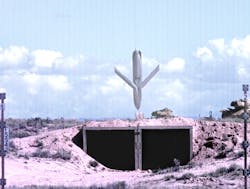Lockheed Martin to test and integrate extreme-range air-to-ground missile with GPS and infrared guidance
EGLIN AIR FORCE BASE, Fla. – Missile designers at Lockheed Martin Corp. will help the U.S. Air Force develop an extreme-range precision-guided air-to-ground missile to attack and destroy high-value enemy targets under terms of a potential $240 million contract announced last week.
Officials of the U.S. Air Force Life Cycle Management Center at Eglin Air Force Base, Fla., are asking the Lockheed Martin Missiles and Fire Control segment in Orlando, Fla., to develop, test, and integrate the AGM-158D advanced version of the Joint Air-to-Surface Standoff Missile (JASSM).
JASSM, which has been in service since 2009, is a long-range, conventional, air-to-ground, precision standoff missile for U.S. and allied forces that is designed to destroy high-value, well-defended, fixed and relocatable targets. The JASSM has a range of 230 miles, while the extended-range JASSM-ER has a range of 620 miles.
The 5,000-pound AGM-158D will nearly double the range of the JASSM-ER to 1,200 miles and carry an explosive warhead of 2,000 pounds by using an enhanced wing design, new missile control unit, a different paint coating, an electronic safe and arm fuze, and secure GPS receiver. The first AGM-158D are scheduled for deliveries in January 2024.
The JASSM-ER is a 2,250-pound cruise missile with a 1,000-pound penetrator and blast-fragmentation warhead. It uses precision routing and guidance in adverse weather, day or night, using an infrared seeker in addition to the anti-jam GPS to find a specific aim point on the target. The order includes hardware spares.
The stealthy JASSM missiles have standoff ranges to keep air crews well out of danger from hostile air defense systems, while their stealthy airframes makes the smart munitions extremely difficult to defeat, Lockheed Martin officials say.
The AGM-158B JASSM-ER is a stealthy cruise missile that flies a preplanned route from launch to a target, using Global Positioning System (GPS) satellite navigation guidance and an internal navigation system. It has an infrared seeker for terminal guidance.
JASSM can be fired from several different aircraft, including the B-1, B-2, B-52, F-16, F/A-18E/F, and F-15E. International JASSM users include the Australian, Finnish, and Polish air forces.
Looking to the future, Lockheed Martin is working on the JASSM to enable the missile to fire from U.S. and international versions of the Lockheed Martin F-35 Lightning II joint strike fighter aircraft and other international military aircraft.
On this contract Lockheed Martin will do the work in Orlando, Fla. and Troy, Ala., and should be finished by February 2025. For more information contact Lockheed Martin Missiles and Fire Control online at www.lockheedmartin.com, or the Air Force Life Cycle Management Center at www.aflcmc.af.mil.

John Keller | Editor-in-Chief
John Keller is the Editor-in-Chief, Military & Aerospace Electronics Magazine--provides extensive coverage and analysis of enabling electronics and optoelectronic technologies in military, space and commercial aviation applications. John has been a member of the Military & Aerospace Electronics staff since 1989 and chief editor since 1995.

